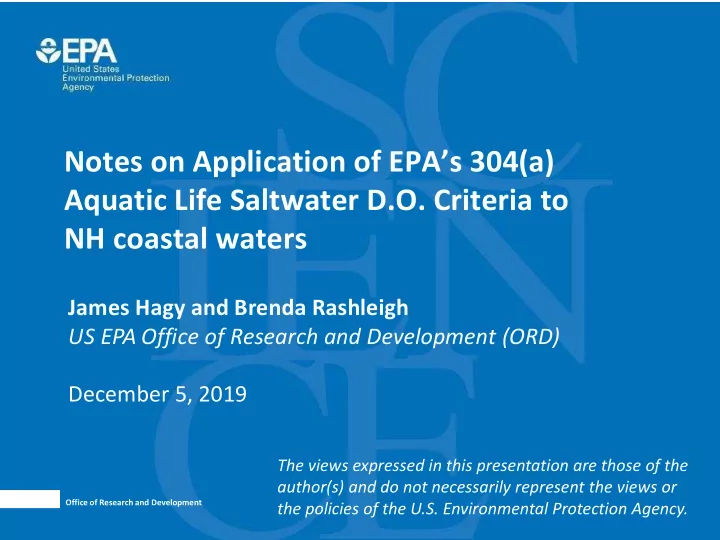

Notes on Application of EPA’s 304(a) Aquatic Life Saltwater D.O. Criteria to NH coastal waters James Hagy and Brenda Rashleigh US EPA Office of Research and Development (ORD) December 5, 2019 The views expressed in this presentation are those of the author(s) and do not necessarily represent the views or 1 Office of Research and Development the policies of the U.S. Environmental Protection Agency.
EPA’s Aquatic Life Criteria Guidance is one reference point for D.O. criteria in NH • “Virginian Province Approach” is EPA’s Three-part criteria approach in Saltwater Aquatic Life D.O. criteria guidance. EPA guidance • Acute (2.3 mg/L) and Chronic (4.8 mg/L) criteria are based on lab Chronic threshold (CCC) - D.O. exposure tests for most sensitive above this level expected juveniles and adults. to protect aquatic life • In practice, states have made Recruitment curve – effects adjustments for local species, temperature, or other factors. on sensitive larvae • New science has identified additional considerations, such as interaction of Acute threshold (CMC) - D.O. low D.O. and low pH effects. Duration below this level causes acute • EPA guidance also specifies that D.O.- mortality of sensitive threatened and endangered juveniles and adults species should be considered separately when criteria applies to habitat. 2
Larval Recruitment model estimates impairment of fish recruitment by low D.O. Fish Start Spawning Larval • Larval recruitment model portion of Species day season length Development saltwater guidance utilizes life history (days) Time (days) and D.O. sensitivity parameters. Atlantic 127 90 28 sturgeon • Estimates overall impact of low D.O. Shortnose 118 45 12 on seasonal recruitment sturgeon 6 resident species were evaluated as • requested by NHDES Alewife 120 45 30-40 • Used LC50 = 3.15 mg/L for all species Blueback 125 61 30 herring • Long spawning season length is American 136 75 2-7 relevant for exposure of Atlantic shad sturgeon larvae to low oxygen. Rainbow 95 61 30-45 smelt 3
Existing D.O. levels at Lamprey River may impact Atlantic sturgeon recruitment • Most spawning is estimated to occur before low D.O. events. Fish Species GRBGB GRBSQ GRBLR Atlantic sturgeon 0 0 7.5% • EPA guidance targets <5% Shortnose sturgeon 0 0 0 impairment. Alewife 0 0 0 Blueback herring 0 0 0 • With uniform spawning, American shad 0 0 0 Atlantic sturgeon at Lamprey Rainbow smelt 0 0 0 River overlap low D.O. events, 1200 6 suggesting possible 1000 5 CCC recruitment impacts. Cohort Size Spawning Activity D.O. (mg/L) 800 4 • Future shift toward earlier low 3 600 D.O. events or extended 400 2 spawning could cause greater Low D.O. 200 1 overlap and larger effects. Events 0 0 J F M A M J J A S O N D 4 Month
D.O. vs. pH in D.O. Exposure Tests differed from D.O. vs. pH in natural waters 8.3 EPA Tests EPA tests in 1990s • maintained ambient pH. 8.1 In natural waters, low pH • 7.9 and low D.O. occur together. pH 7.7 Recent studies show adverse • Narragansett Bay effects of low pH and D.O. 7.5 Long Island Sound can be additive. 7.3 Laboratory thresholds may • underestimate D.O. levels 7.1 needed to prevent impacts 6.9 in natural waters subject to 0 2 4 6 8 10 DO (mg/L) co-occuring low pH. 5
Question or Comments? James Hagy US EPA / Office of Research and Development Center for Environmental Measurement and Modeling hagy.jim@epa.gov Brenda Rashleigh US EPA / Office of Research and Development Center for Public Health and Environmental Assessment rashleigh.brenda@epa.gov 6
Recommend
More recommend